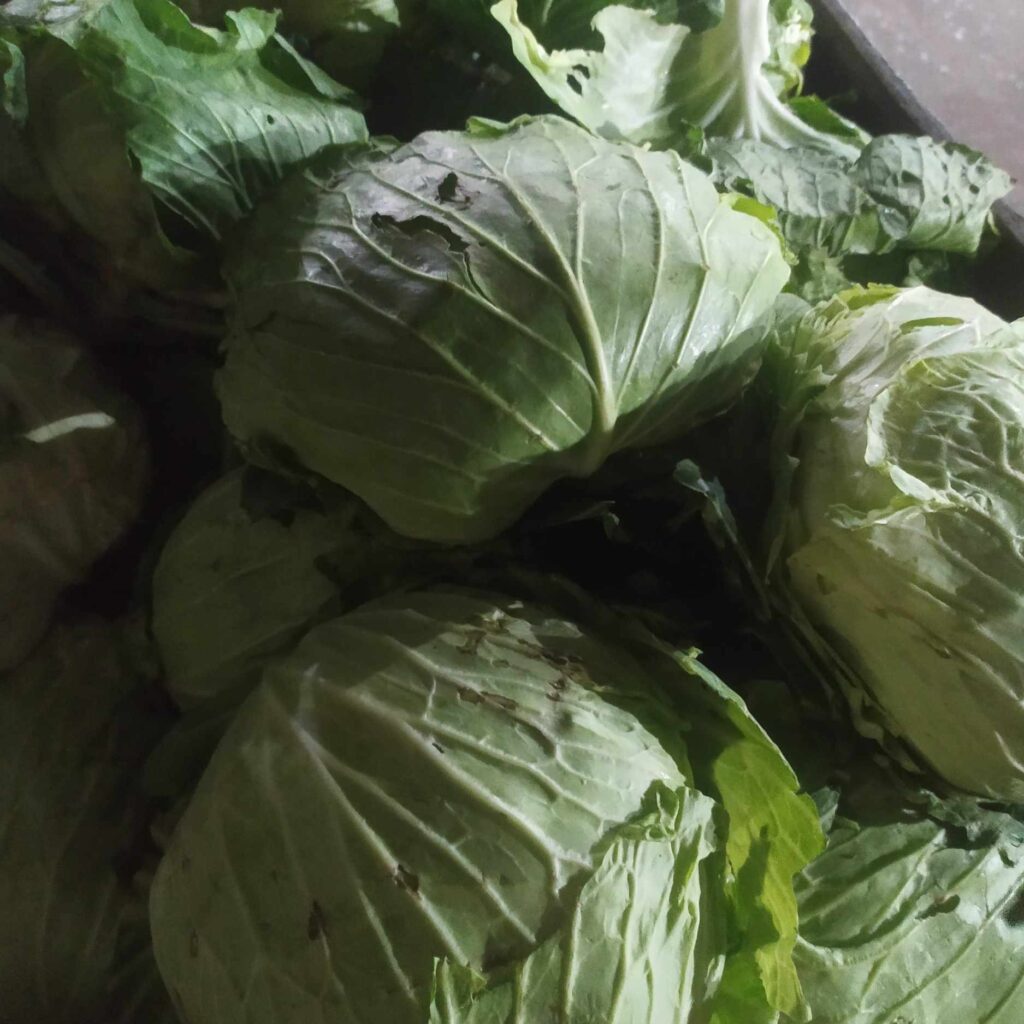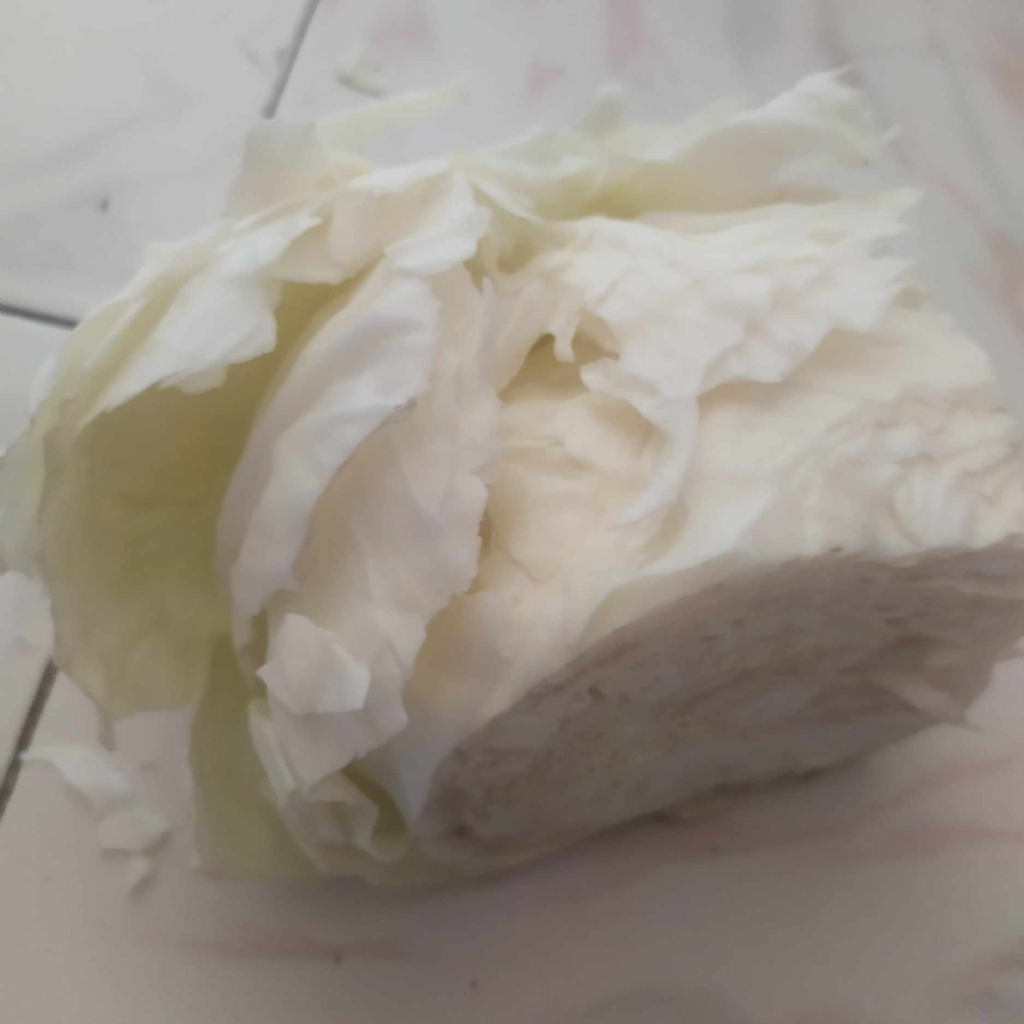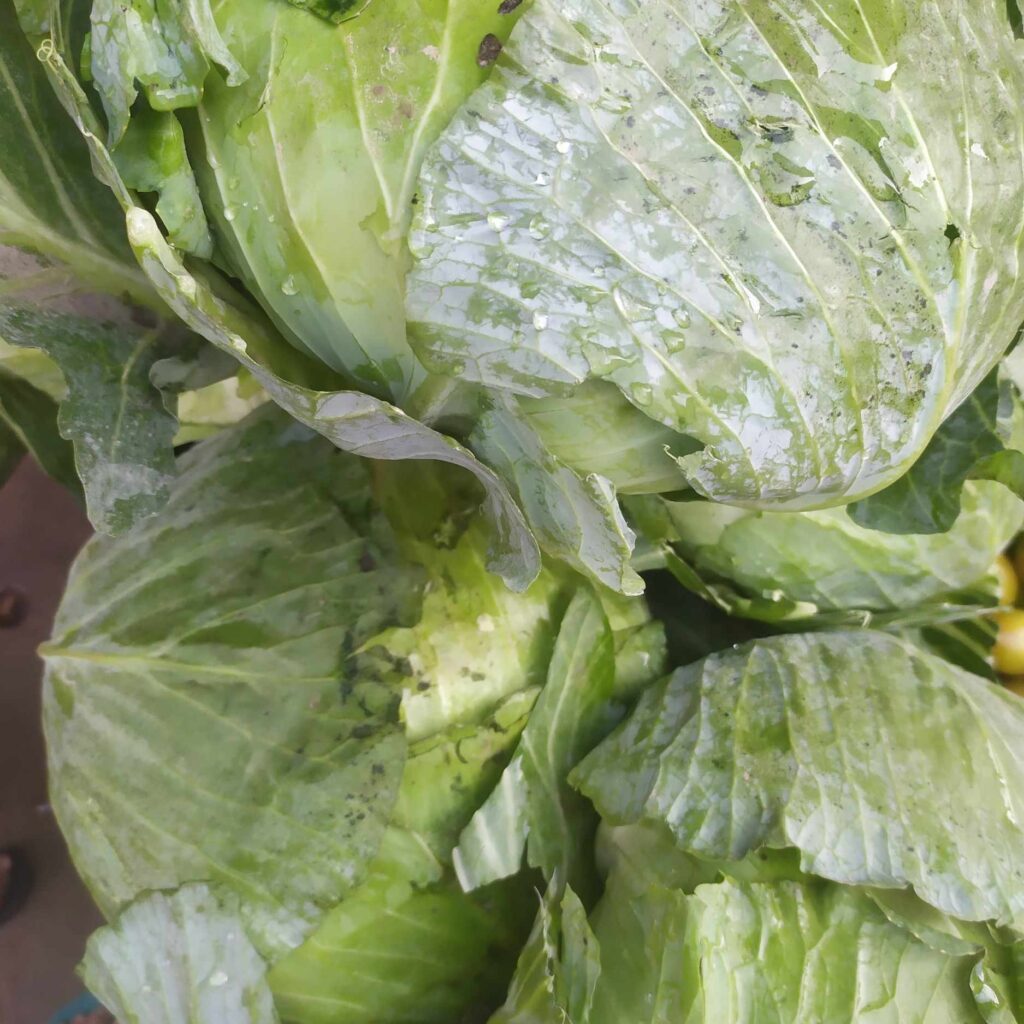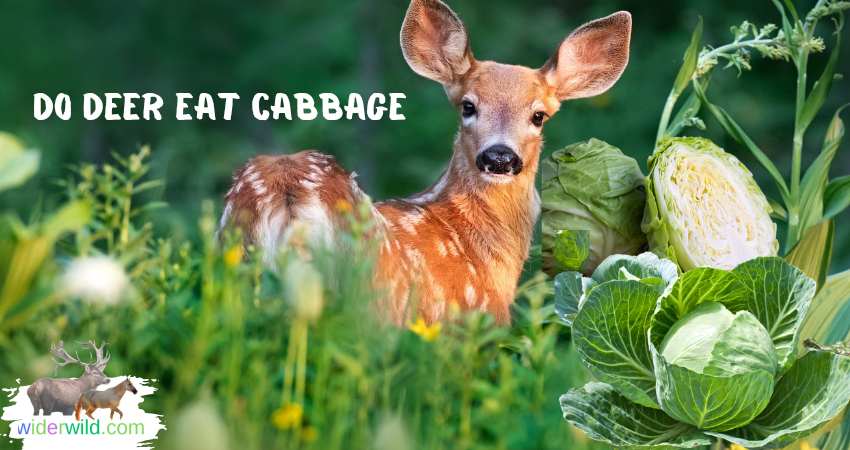Yes, deer do eat cabbage. They are known to feed on various plants, including cabbage, in their natural habitat.
Deer are herbivorous animals that are found in various parts of the world. While they primarily graze on grass, leaves, and twigs, they can also consume other plants, including vegetables. One such vegetable that deer have been known to eat is cabbage.
Cabbage is a leafy green vegetable that is commonly grown in gardens and farms. It is highly nutritious and rich in vitamins and minerals, making it an excellent dietary choice for humans. However, it also appeals to deer due to its tender leaves and succulent taste.
In areas where deer populations are prevalent, such as rural and suburban regions, farmers and gardeners often face the challenge of protecting their cabbage plants from being devoured by these grazing animals.
I will explore the deer feeding habits of deer and their preference for cabbage as a food source.
| Ingredient | Description |
|---|---|
| Cabbage | Leafy green vegetable, a member of the Brassica family |
| Water | Essential for plant growth and development |
| Soil | Nutrient-rich medium for cultivation |
| Sunlight | Required for photosynthesis, vital for plant health |
| Fertilizer | Provides additional nutrients for optimal growth |
| Pest Control Measures | Prevents damage from insects and pests |
| Deer Repellent | Acts as a deterrent to discourage deer from consuming cabbage |
Deer-Friendly Gardening Tips: The Adaptive Palate
When choosing plants that claim to be deer-resistant, it’s essential to recognize that deer are quite adaptable in their taste preferences.
These creatures can adjust their palate to various situations, often nibbling on a wide range of plants and occasionally rejecting what they find unappealing. Unfortunately, this adaptability can lead to significant damage for gardeners.
Even plants labeled as deer-resistant can eventually become appealing food sources for these animals when grouped.
As a result, all plants can be considered only slightly resistant, with some providing a bit more protection. Understanding the adaptive palate of deer is key to creating a garden that minimizes the risk of damage while maintaining aesthetic appeal.
The Relationship Between Deer And Cabbage
Deer, with their diverse diets, are known to consume a wide variety of vegetation. One of the plants that often falls prey to these herbivorous creatures is cabbage.
It is interesting to delve into the relationship between deer and cabbage and understand why deer find this leafy vegetable so enticing amidst their natural habitat.
Cabbage As A Nutritious Food Source For Deer

Cabbage serves as a valuable food source for deer due to its high nutritional content. Packed with vitamins, minerals, and essential nutrients, cabbage provides deer with the sustenance they need for survival.
This leafy vegetable is particularly rich in vitamin C, which helps boost the immune system of these majestic creatures. Additionally, the high fiber content of cabbage aids in digestion and ensures optimal gut health for deer.
Examining The Feeding Habits Of Wild Deer
When examining the diet of wild deer, it becomes apparent that alongside grasses and shrubs, they often incorporate cabbage into their feeding habits.
While deer are primarily ruminants, relying on grasses and other plants for sustenance, they readily explore other food options, including cabbage, when available. This adaptive behavior showcases the versatility of deer in their feeding patterns.
Factors That Influence Deer’s Preference For Cabbage

Several factors influence a deer’s preference for cabbage as a food source. The sweet and tender leaves of cabbage make it an appealing option for deer, often leading them to prioritize it over other vegetation.
Furthermore, the scent of cabbage can attract deer from a distance, arousing their curiosity and drawing them towards this leafy green feast. The accessibility of cabbage within their habitat and the absence of significant deterrents also contribute to their preference for this particular vegetable.
Seasonal Variations In Cabbage Consumption
The consumption of cabbage by deer can vary depending on the season. In the colder months, with limited availability of other fresh greens, deer tend to consume cabbage more frequently.
The high water content of cabbage helps meet their hydration needs during this period when water sources may be frozen. However, during warmer seasons, when a range of other vegetation is abundant, the consumption of cabbage may decrease.
Environmental Factors Affecting Deer Behavior
Various environmental factors influence deer behavior, including their feeding patterns. The availability of cabbage within the habitat, the presence of natural predators, and competition with other herbivores can all affect a deer’s inclination to consume cabbage.
Additionally, deer tend to adapt to their surroundings and make feeding choices based on the resources available.
Whether as a nutritious food source, a seasonal delicacy, or influenced by various environmental factors, the consumption of cabbage by deer reflects their adaptability and resourcefulness in the wild.

Cabbage As A Potential Threat To Deer
Cabbage, a popular vegetable known for its many health benefits and versatile culinary uses, can present a potential threat to deer. While deer typically feed on grasses, leaves, and other vegetation, they have been known to graze on cabbage plants when other food sources are scarce.
Potential Consequences Of Deer Feeding On Cabbage
When deer feed on cabbage plants, it can have significant consequences for both farmers and the deer population itself. Cabbage is a valuable crop, and damage caused by deer feeding can result in reduced crop yield and financial losses for farmers.
For deer, consuming cabbage can lead to digestive issues and disrupt their natural feeding patterns. Additionally, excessive feeding on cabbage can cause damage to the plants, making them vulnerable to diseases and pests.
Impact On Crop Yield And Farming Practices
The impact of deer feeding on cabbage can be detrimental to crop yield and overall farming practices. When deer consume cabbage leaves, they can strip the plants of their foliage, reducing the plant’s ability to photosynthesize and produce energy.
This can result in stunted growth, reduced head formation, and lower crop yield. Farmers may also need to invest more time and resources in pest control measures to counteract the damage caused by deer.
Mitigation Strategies To Prevent Deer-cabbage Conflict

To prevent deer-cabbage conflict and minimize the damage caused by deer feeding, various mitigation strategies can be employed.
These strategies aim to deter deer from consuming cabbage or protect the crop through physical barriers and cultivation techniques. Some effective mitigation strategies include:
Natural Deterrents and Repellents
Using natural deterrents and repellents can help discourage deer from approaching cabbage plants. Deer are sensitive to strong smells and tastes, so products such as garlic-based sprays, predator urine, or soap bars can be used to create unpleasant scents and flavors around the plants.
These natural deterrents can help repel deer and prevent them from feeding on the cabbage.
Implementing Barriers- Fencing and Physical Barriers
Installing fences or other physical barriers around the cabbage field is a reliable method to prevent deer from accessing the crop. Deer-proof fences should be at least 8 feet tall and made of sturdy materials to effectively deter deer.
Additionally, electric fences can provide an added layer of protection by delivering a mild shock to deter deer attempts to cross the barrier.
Cultivation Techniques to Minimize Deer Damage
Certain cultivation techniques can help minimize deer damage to cabbage plants. Placing decoy crops or sacrificial vegetation at the edge of the field can redirect deer away from the main crop.
Intercropping cabbage with other plants that deer find less appealing can also help reduce the damage caused by deer feeding.
Additionally, regularly monitoring the cabbage field for signs of deer activity can allow farmers to intervene promptly and implement appropriate control measures.
The Impact Of Human Activities On Deer Behavior
As human civilization expands, so does the impact on wildlife populations. The destruction of natural habitats, fragmentation of forests, and the growth of suburban areas have forced deer to adapt to new environments.
These changes in their surroundings can lead to altered behavior patterns and an increased reliance on easily accessible food sources, such as crops.
With fewer natural feeding options available, deer are drawn to the lush, leafy greens of cabbage fields. The proximity of these crops to human settlements further exacerbates the issue, bringing deer into direct conflict with farmers and leading to significant economic losses.
Protecting Cabbage Crops From Deer
Deer can be a significant threat to cabbage crops, as they are known to eat the leaves and damage the plants. Protecting cabbage crops from deer requires implementing effective deterrents such as fencing, repellents, and scare devices.
Understanding Deer Behavior And Feeding Patterns
Deer are notorious for causing damage to cabbage crops. They are known to have a voracious appetite and can quickly decimate a patch of cabbage if left unchecked.
To effectively protect cabbage crops from deer, it is essential to understand their behavior and feeding patterns. Deer are most active during the early morning and late evening hours, so it is crucial to implement deterrent measures during these times.
They are attracted to the succulent leaves of the cabbage plant and will continue to feed on them until there is nothing left. This behavior makes cabbage crops particularly vulnerable during the growing season.
Effective Methods Of Deer Deterrence In Agricultural Settings
In agricultural settings, protecting cabbage crops from deer requires implementing effective deer deterrence strategies. One of the most popular methods is the use of fencing. Installing a sturdy fence around the cabbage patch can create a physical barrier that prevents deer from accessing the plants.
The fence should be at least 8 feet tall and buried at least 12 inches into the ground to discourage deer from digging underneath it. Additionally, using visual deterrents such as scarecrows or moving objects can help deter deer from approaching the cabbage crops.
Implementing Integrated Pest Management Strategies
Implementing integrated pest management (IPM) strategies can be highly effective in deterring deer from cabbage crops.
IPM involves a combination of preventative measures, monitoring, and control methods to manage pests while minimizing environmental impact.
In the case of deer damage to cabbage crops, preventative measures such as the use of fencing and visual deterrents play a crucial role in deterring deer. Regular monitoring of the cabbage patch can help identify any signs of deer activity early on, allowing for timely intervention.
If deer damage does occur, control methods such as the use of repellents or employing trained dogs to scare away deer can help mitigate the damage.
Non-lethal Solutions For Deer Cabbage Damage
Deer cabbage damage can be a significant concern for cabbage farmers, but it is important to note that there are non-lethal solutions available to address this issue.
Instead of resorting to hunting or other lethal methods, farmers can opt for non-lethal deer deterrents. These include incorporating natural deer repellents into the cabbage crop, such as predator urine or scented soaps.
These odors can create an aversive environment for deer, deterring them from feeding on the cabbage crops. Another non-lethal solution is the use of motion-activated sprinklers, which emit bursts of water when deer approach the area, startling and discouraging them from continuing to browse the cabbage.
Role Of Scarecrows And Other Deterrent Devices
Scarecrows and other deterrent devices play a vital role in protecting cabbage crops from deer. Scarecrows, traditionally made of straw or cloth and placed strategically within the cabbage patch, are intended to give the impression of a human presence.
The movement of scarecrows, whether through wind or intentional design, can help frighten deer away from the crops. Additionally, other deterrent devices such as noise-making devices, reflective tapes, or even predator decoys can be effective in deterring deer from approaching the cabbage crops.
By incorporating these methods, farmers can create an environment that dissuades deer from causing damage to their valuable cabbage crops.
4 Points As Short Summary for Deer Feeding Cabbage Are:
- 1. Deer Resilience: Deer can adapt their palate, making even plants labeled as deer-resistant susceptible to becoming future food sources when grouped. This adaptability poses challenges for gardeners as all plants are only slightly resistant, and some may become palatable over time.
- 2. Cabbage Vulnerability: Deer have a strong preference for cabbage and can consume substantial amounts, causing damage to leaves, buds, and fruit. To protect cabbage gardens, planting alternative deer-resistant options like cucumber and rhubarb is advised. Ornamental cabbage is also a viable choice as deer tend to avoid ornamental plants.
- 3. Effective Barriers: Fences are recommended for effective deer control, with options like an 8-inch tall fence or two parallel fences of 5-6 inches placed two inches apart. Outward-slanting fences can deter deer from attempting to jump over, providing a physical barrier against their intrusion.
- 4. Comprehensive Protection Strategies: While fences are a primary defense, a holistic approach involves combining methods such as deer repellents, strategic planting of deer-resistant plants, and occasional use of scare tactics or noise deterrents.
Frequently Asked Questions On Do Deer Eat Cabbage?
Do Deer Eat Cabbage In Gardens?
Yes, deer are known to eat cabbage in gardens as it is a tempting and nutritious plant for them.
How Can I Protect My Cabbage From Deer?
To protect your cabbage from deer, you can use a combination of fencing, netting, repellents, and planting companion plants that deer dislike.
Are There Any Cabbage Varieties That Deer Dislike?
Yes, certain cabbage varieties like Savoy cabbage and Red cabbage are less appealing to deer due to their strong taste and texture.
What Are Some Natural Deer Repellents For Cabbage?
Some natural deer repellents for cabbage include placing garlic or soap flakes around the plants, using strong-smelling herbs like mint or rosemary, or spraying a mixture of water and hot pepper.
Do Scarecrows Work To Keep Deer Away From Cabbage?
Scarecrows alone are not very effective in keeping deer away from cabbage. However, using scarecrows along with other deterrents can help enhance their effectiveness.
Can I Plant Deer-resistant Flowers Near Cabbage To Deter Them?
Yes, planting deer-resistant flowers like marigolds, daffodils, or lavender near your cabbage can help deter deer as they dislike the smell of these plants.
Why Do Deer Like Cabbage So Much?
Deer are attracted to cabbage due to its high nutritional value and tender leaves. The sweet taste and succulent texture make it a favorite food for them.
Final Words
Deer do indeed have a penchant for cabbage. Their foraging habits can wreak havoc on cabbage crops, causing significant damage for farmers and gardeners alike.
However, to mitigate this issue, various methods can be employed, such as the use of deterrents or protective measures to keep deer at bay.
By implementing these strategies, individuals can successfully protect their cabbage plants and enjoy a bountiful harvest.
Related Post On Deer Diet and Feeding:

